| Contents
Home
General
Info
Ordering
Info
Contact us
Cartridge
Lists
Patent & Miscellaneous
Rim Fire
Center Fire Pistol
Center Fire Rifle
Metric Rimfire,
Pistol&Rifle
British Pistol and Rifle
Shotgun Shells
Posters
This Month's Picture Page
Prior Picture Pages:
*
September 2003
*
October 2003
*
November 2003
*
December 2003
*
January 2004
*
February 2004
*
March 2004
*
April 2004
*
May 2004
*
June 2004
*
July 2004
*
August 2004
*
September 2004
*
October 2004
*
November 2004
*
December
2004
*
January 2005
Links to Other Sites
Cartridge Collectors Organizations:
IAA
ECRA
SAAACA
Auctions:
Auction
Arms
E-Bay
Ward's Collectibles
Sold USA
Books:
Armory
Publications
WCF Publications
Other Collector's Sites:
Curtis Steinhauer
|
Picture
Page
February
2005
A couple of .455 'Manstoppers'........
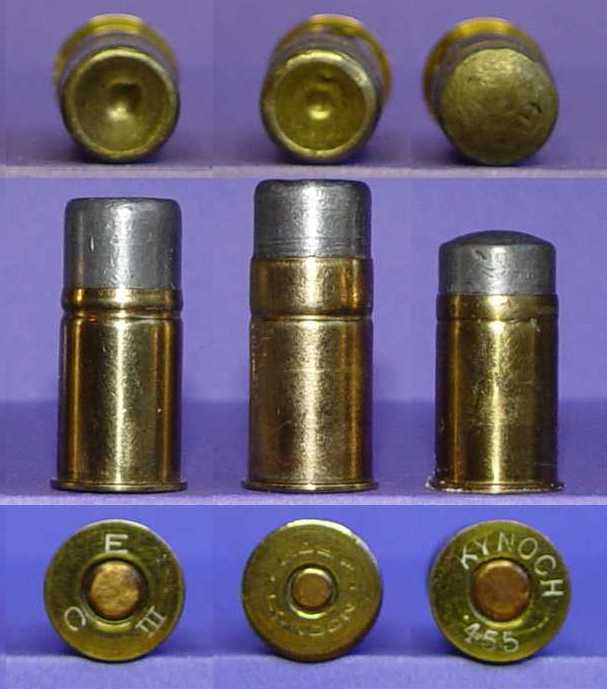
In
1898, the .455 Webley Mark III cartridge was adopted for British service
revolver use, having a deep nose cavity that provided increased stopping
power over the Mk I and Mk II versions of the cartridge. The 220 grain
bullet was referred to as the 'manstopper'. Within two years, the Mark III
cartridge was removed from service, a result of the 1899 Hague Convention
outlawing hollow point bullets of any type for military use. The first
cartridge in the picture is one of the Mark III cartridges made by Eley
Brothers for the British government. The 'C' in the headstamp indicates that
the cartridge is loaded with cordite, an early form of smokeless powder. The
case on this cartridge is approximately .760" long. The second cartridge
also sports a manstopper bullet,
but was intended for the commercial market or perhaps constabulary use. It
is headstamped 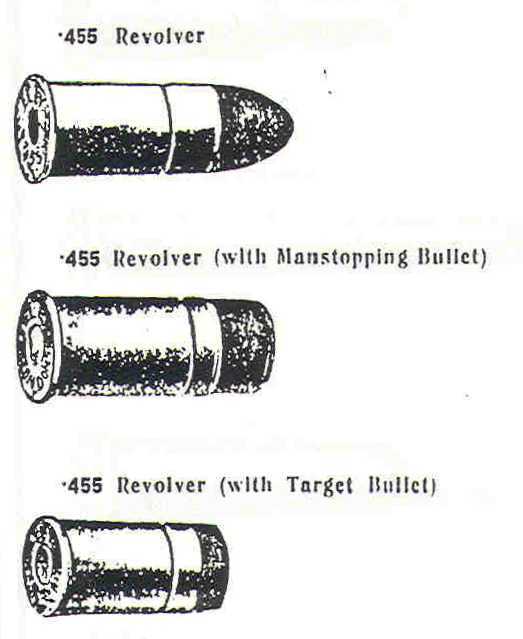 'ELEY . LONDON .', and has the longer (~.870")
case that was used for the black powder .455 Mark I cartridge. The last
cartridge, headstamped KYNOCH .455, is also a commercial load and is
loaded with a slightly rounded blunt bullet intended for target shooting. 'ELEY . LONDON .', and has the longer (~.870")
case that was used for the black powder .455 Mark I cartridge. The last
cartridge, headstamped KYNOCH .455, is also a commercial load and is
loaded with a slightly rounded blunt bullet intended for target shooting.
>
>
>
>
>
>
>
Two variations of the .50 Meigs
cartridge.......
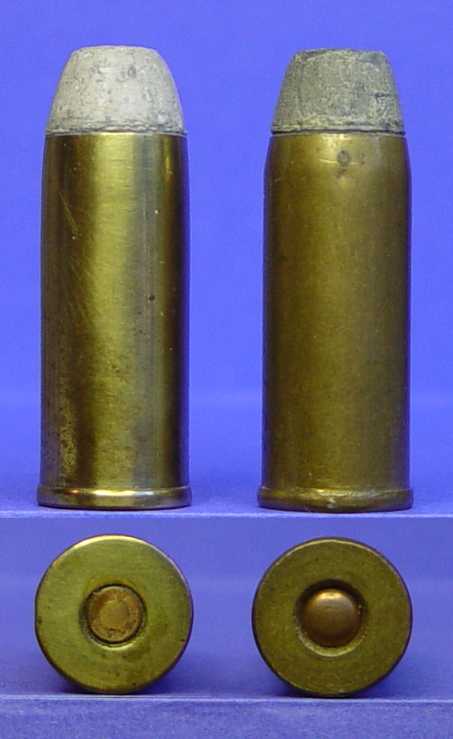 The .50 Meigs is a mystery cartridge that no-one seems to know a great
deal about. They are purported to have been produced on a limited basis at
the United States Cartridge Company by J. V. Meigs. While a goodly number of
the cartridges seem to be floating around, no one seems to have positively
identified the firearm that these were used in. The cartridges shown here are a
couple of the variations of the .50 Meigs, the differences being the types of
primers used, with the one on the left having a Farrington primer, used
exclusively by the US Cartridge company, and the other having what appears
to be a conventional Boxer-style primer. Another variation that I'm aware of
has a longer, more cone-shaped bullet. The .50 Meigs is a mystery cartridge that no-one seems to know a great
deal about. They are purported to have been produced on a limited basis at
the United States Cartridge Company by J. V. Meigs. While a goodly number of
the cartridges seem to be floating around, no one seems to have positively
identified the firearm that these were used in. The cartridges shown here are a
couple of the variations of the .50 Meigs, the differences being the types of
primers used, with the one on the left having a Farrington primer, used
exclusively by the US Cartridge company, and the other having what appears
to be a conventional Boxer-style primer. Another variation that I'm aware of
has a longer, more cone-shaped bullet.
>
>
>
>
>
An assortment of Marlin .40-60
cartridges.....
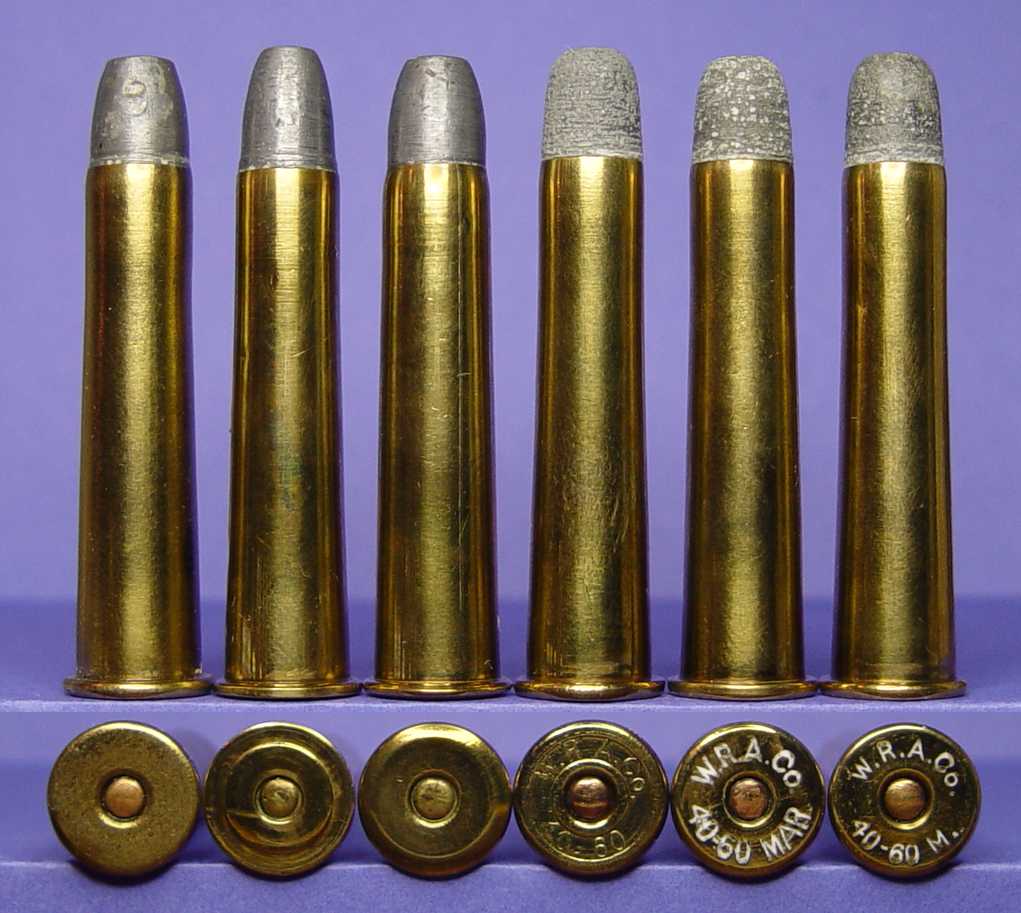
This is a fairly complete grouping of the Marlin .40-60 cartridge, which
was developed in 1883 by Marlin for use in their Model 1881 repeating rifle.
Marlin did not have its own ammunition making facility, and initially
contracted with Winchester, its main competitor in the repeating rifle
market, and the Union Metallic Cartridge Company to produce its ammunition.
Cartridges in the first picture include three unheadstamped examples, made
by (from the left) Winchester, UMC and Remington, followed by a
Winchester raised headstamp and two variations of Winchester impressed
headstamps. The
second picture includes two raised headstamps by UMC loaded with a lead
bullet and a full metal cased bullet, two variations of the UMC impressed
headstamps, and finally a Dominion Cartridge Company example. One thing that
Marlin insisted on was that its cartridges be fitted with small primers,
which all of those pictured have. The purpose of the small primers was to
reduce the possibility of cartridges in a tubular magazine from being
detonated
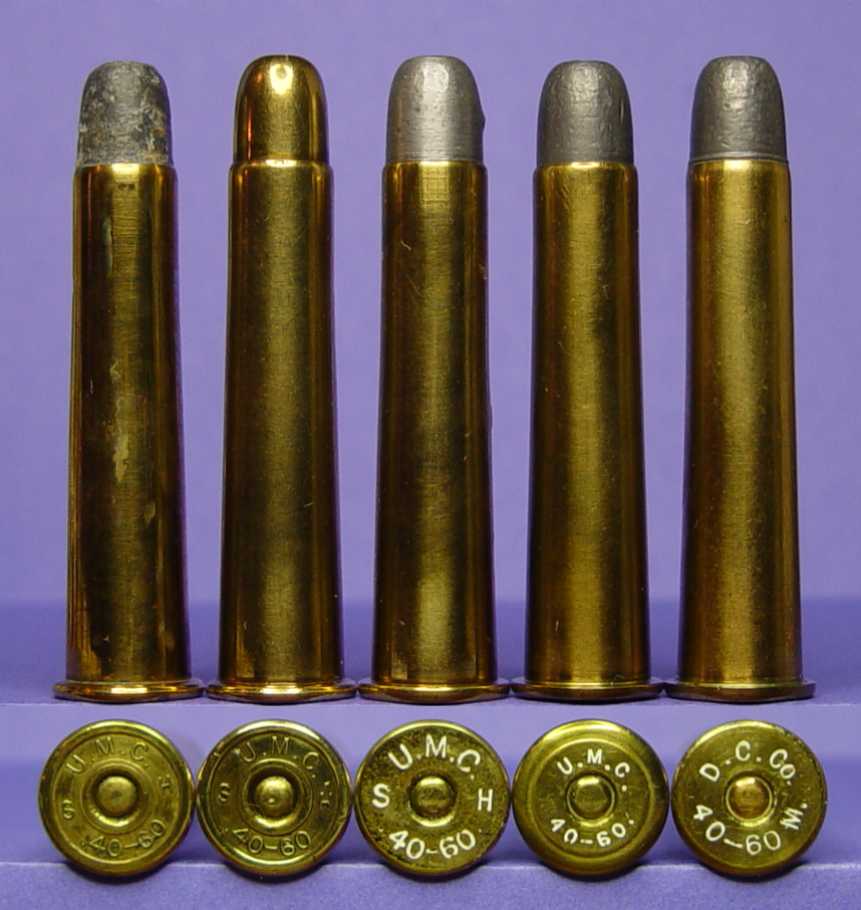 as a result of a jolt, or from the recoil resulting from firing.
In January of 1887, following receiving complaints of missfires with its
rifles, Marlin launched an advertising campaign accusing Winchester of
producing sub-standard ammunition which tended to mis-fire in the Marlin
rifles. The problem apparently involved primer pockets which were deeper
than Marlin specifications called for, resulting in the primers being seated
too far into the heads of the cases to allow dependable ignition. As a
result of the bad feelings that developed between the two companies over
this controversy, Marlin terminated its business relationship with
Winchester. It is interesting to note that the .40-65 WCF cartridge which
Winchester introduced in 1887 for use in their Model 1886 rifle uses
the same cartridge case as the Marlin .40-60. One has to wonder if the
company had originally intended to produce this cartridge, or if they
did so for the purpose of increasing competition with Marlin, as well as
allowing them to make use of the .40-60 Marlin cartridge case forming tools
that they would otherwise have little use for. as a result of a jolt, or from the recoil resulting from firing.
In January of 1887, following receiving complaints of missfires with its
rifles, Marlin launched an advertising campaign accusing Winchester of
producing sub-standard ammunition which tended to mis-fire in the Marlin
rifles. The problem apparently involved primer pockets which were deeper
than Marlin specifications called for, resulting in the primers being seated
too far into the heads of the cases to allow dependable ignition. As a
result of the bad feelings that developed between the two companies over
this controversy, Marlin terminated its business relationship with
Winchester. It is interesting to note that the .40-65 WCF cartridge which
Winchester introduced in 1887 for use in their Model 1886 rifle uses
the same cartridge case as the Marlin .40-60. One has to wonder if the
company had originally intended to produce this cartridge, or if they
did so for the purpose of increasing competition with Marlin, as well as
allowing them to make use of the .40-60 Marlin cartridge case forming tools
that they would otherwise have little use for.
Thanks to Howard Hoovestal for identifying the 'bevel head' cartridge in
the first picture for me as a Remington product. This should have been a
little more apparent to me, given the other cartridges with this
characteristic head that are known to have been made by Remington, the
fairly common .38-40 Remington 1 3/4" straight being an example that readily
comes to mind.
>
>
Development of the 30-06 cartridge.....
The three cartridges on the left side of this picture represent different
stages in the development of the .30-06 Springfield. The first cartridge is
possibly one of a small number of experimental rimless cartridges made at
Frankford
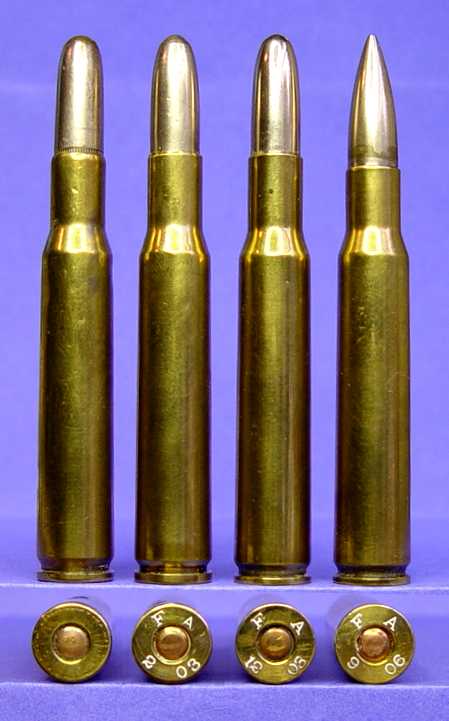 Arsenal in February of 1901. It is unheadstamped, has a grooved
bullet, and the case has a thick extractor flange (or rim). This cartridge
soon was referred to as the Caliber .30 Ball Cartridge, Model 1901, and went
through a number of changes, including the adoption of a smooth jacketed
bullet in place of the grooved one used earlier. The second cartridge is one
of these Model 1901 cartridges, this one made in February of 1903. This
cartridge is referred to by collectors as the 'thick rim', for the obvious reason that its rim is much thicker than those
of the Model 1903 and Model 1906 cartridges that succeeded it, represented
in the picture by cartridges three and four, respectively. The Model 1901
cartridge was made from June of 1901 through May of 1903. Production of the
Model 1903 cartridge, with its thinner rim, began in September of 1903 and
ended in October of 1906. In addition to its pointed spitzer style bullet,
the Model 1906 cartridge differed from the1903 in the length of its case,
the 1906 case being about 1/10" shorter. Production of the new cartridge
began in September of 1906; the fourth cartridge is one of that first
month's production. Any earlier headstamped cartridges that conform to Model
1906 case dimensions are made from shortened Model 1903 cases. Arsenal in February of 1901. It is unheadstamped, has a grooved
bullet, and the case has a thick extractor flange (or rim). This cartridge
soon was referred to as the Caliber .30 Ball Cartridge, Model 1901, and went
through a number of changes, including the adoption of a smooth jacketed
bullet in place of the grooved one used earlier. The second cartridge is one
of these Model 1901 cartridges, this one made in February of 1903. This
cartridge is referred to by collectors as the 'thick rim', for the obvious reason that its rim is much thicker than those
of the Model 1903 and Model 1906 cartridges that succeeded it, represented
in the picture by cartridges three and four, respectively. The Model 1901
cartridge was made from June of 1901 through May of 1903. Production of the
Model 1903 cartridge, with its thinner rim, began in September of 1903 and
ended in October of 1906. In addition to its pointed spitzer style bullet,
the Model 1906 cartridge differed from the1903 in the length of its case,
the 1906 case being about 1/10" shorter. Production of the new cartridge
began in September of 1906; the fourth cartridge is one of that first
month's production. Any earlier headstamped cartridges that conform to Model
1906 case dimensions are made from shortened Model 1903 cases.
|


 'ELEY . LONDON .', and has the longer (~.870")
case that was used for the black powder .455 Mark I cartridge. The last
cartridge, headstamped KYNOCH .455, is also a commercial load and is
loaded with a slightly rounded blunt bullet intended for target shooting.
'ELEY . LONDON .', and has the longer (~.870")
case that was used for the black powder .455 Mark I cartridge. The last
cartridge, headstamped KYNOCH .455, is also a commercial load and is
loaded with a slightly rounded blunt bullet intended for target shooting. The .50 Meigs is a mystery cartridge that no-one seems to know a great
deal about. They are purported to have been produced on a limited basis at
the United States Cartridge Company by J. V. Meigs. While a goodly number of
the cartridges seem to be floating around, no one seems to have positively
identified the firearm that these were used in. The cartridges shown here are a
couple of the variations of the .50 Meigs, the differences being the types of
primers used, with the one on the left having a Farrington primer, used
exclusively by the US Cartridge company, and the other having what appears
to be a conventional Boxer-style primer. Another variation that I'm aware of
has a longer, more cone-shaped bullet.
The .50 Meigs is a mystery cartridge that no-one seems to know a great
deal about. They are purported to have been produced on a limited basis at
the United States Cartridge Company by J. V. Meigs. While a goodly number of
the cartridges seem to be floating around, no one seems to have positively
identified the firearm that these were used in. The cartridges shown here are a
couple of the variations of the .50 Meigs, the differences being the types of
primers used, with the one on the left having a Farrington primer, used
exclusively by the US Cartridge company, and the other having what appears
to be a conventional Boxer-style primer. Another variation that I'm aware of
has a longer, more cone-shaped bullet.
 as a result of a jolt, or from the recoil resulting from firing.
In January of 1887, following receiving complaints of missfires with its
rifles, Marlin launched an advertising campaign accusing Winchester of
producing sub-standard ammunition which tended to mis-fire in the Marlin
rifles. The problem apparently involved primer pockets which were deeper
than Marlin specifications called for, resulting in the primers being seated
too far into the heads of the cases to allow dependable ignition. As a
result of the bad feelings that developed between the two companies over
this controversy, Marlin terminated its business relationship with
Winchester. It is interesting to note that the .40-65 WCF cartridge which
Winchester introduced in 1887 for use in their Model 1886 rifle uses
the same cartridge case as the Marlin .40-60. One has to wonder if the
company had originally intended to produce this cartridge, or if they
did so for the purpose of increasing competition with Marlin, as well as
allowing them to make use of the .40-60 Marlin cartridge case forming tools
that they would otherwise have little use for.
as a result of a jolt, or from the recoil resulting from firing.
In January of 1887, following receiving complaints of missfires with its
rifles, Marlin launched an advertising campaign accusing Winchester of
producing sub-standard ammunition which tended to mis-fire in the Marlin
rifles. The problem apparently involved primer pockets which were deeper
than Marlin specifications called for, resulting in the primers being seated
too far into the heads of the cases to allow dependable ignition. As a
result of the bad feelings that developed between the two companies over
this controversy, Marlin terminated its business relationship with
Winchester. It is interesting to note that the .40-65 WCF cartridge which
Winchester introduced in 1887 for use in their Model 1886 rifle uses
the same cartridge case as the Marlin .40-60. One has to wonder if the
company had originally intended to produce this cartridge, or if they
did so for the purpose of increasing competition with Marlin, as well as
allowing them to make use of the .40-60 Marlin cartridge case forming tools
that they would otherwise have little use for.  Arsenal in February of 1901. It is unheadstamped, has a grooved
bullet, and the case has a thick extractor flange (or rim). This cartridge
soon was referred to as the Caliber .30 Ball Cartridge, Model 1901, and went
through a number of changes, including the adoption of a smooth jacketed
bullet in place of the grooved one used earlier. The second cartridge is one
of these Model 1901 cartridges, this one made in February of 1903. This
cartridge is referred to by collectors as the 'thick rim', for the obvious reason that its rim is much thicker than those
of the Model 1903 and Model 1906 cartridges that succeeded it, represented
in the picture by cartridges three and four, respectively. The Model 1901
cartridge was made from June of 1901 through May of 1903. Production of the
Model 1903 cartridge, with its thinner rim, began in September of 1903 and
ended in October of 1906. In addition to its pointed spitzer style bullet,
the Model 1906 cartridge differed from the1903 in the length of its case,
the 1906 case being about 1/10" shorter. Production of the new cartridge
began in September of 1906; the fourth cartridge is one of that first
month's production. Any earlier headstamped cartridges that conform to Model
1906 case dimensions are made from shortened Model 1903 cases.
Arsenal in February of 1901. It is unheadstamped, has a grooved
bullet, and the case has a thick extractor flange (or rim). This cartridge
soon was referred to as the Caliber .30 Ball Cartridge, Model 1901, and went
through a number of changes, including the adoption of a smooth jacketed
bullet in place of the grooved one used earlier. The second cartridge is one
of these Model 1901 cartridges, this one made in February of 1903. This
cartridge is referred to by collectors as the 'thick rim', for the obvious reason that its rim is much thicker than those
of the Model 1903 and Model 1906 cartridges that succeeded it, represented
in the picture by cartridges three and four, respectively. The Model 1901
cartridge was made from June of 1901 through May of 1903. Production of the
Model 1903 cartridge, with its thinner rim, began in September of 1903 and
ended in October of 1906. In addition to its pointed spitzer style bullet,
the Model 1906 cartridge differed from the1903 in the length of its case,
the 1906 case being about 1/10" shorter. Production of the new cartridge
began in September of 1906; the fourth cartridge is one of that first
month's production. Any earlier headstamped cartridges that conform to Model
1906 case dimensions are made from shortened Model 1903 cases.